固碳的土壤管理
IF 0.7
Q3 AGRONOMY
引用次数: 13
摘要
自大约1750年以来,大气CO2增加了~ 146%,全球温度增加了~ 1°C,因此迫切需要确定储存多余CO2的潜在汇。从历史上看,农业生态系统土壤有机碳(SOC)的耗竭量为135千兆碳(Pg C)。因此,农业生态系统土壤具有封存大气二氧化碳和减缓人为全球变暖的潜力。2017年,在11.3 Pg C的人为排放总量中,4.1 Pg C(36.3%)被陆地碳汇吸收。因此,能够创造积极的土壤/生态系统碳(C)预算的土地利用和土壤管理系统有可能在土壤中储存C。当生物量C的输入超过损失时,就会产生正的土壤C收支。可以在表层(0-30厘米)产生正土壤碳收支的做法是保护性农业、地膜农业、覆盖种植、生物炭和复杂的农业系统。将有机碳纳入地下土壤(30-100厘米)的技术是深根物种和深穴居蚯蚓。土壤有机碳浓度与团聚体、植物有效水量、养分保有量、容重和孔隙度呈正相关。因此,恢复退化土壤的有机碳储量与促进全球粮食和气候安全有关,使农业解决环境问题成为可能。本文章由计算机程序翻译,如有差异,请以英文原文为准。
Soil management for carbon sequestration
An increase in atmospheric CO2 by ∼146% and global temperature by ∼1 °C since the year ca. 1750 has created an urgency to identify potential sinks for storage of excess CO2. The historic depletion of soil organic carbon (SOC) from agroecosystems is 135 petagrams of carbon (Pg C). Thus, soils of agroecosystems have a potential to sequester atmospheric CO2 and mitigate anthropogenic global warming. Of the total anthropogenic emissions of 11.3 Pg C in 2017, 4.1 Pg C (36.3%) was absorbed by land-based sinks. Hence, land-use and soil management systems that can create a positive soil/ecosystem carbon (C) budget have a potential to store C in soil. A positive soil C budget is created when input of biomass-C exceeds that of losses. Practices that can create a positive soil C budget in the surface layer (0–30 cm) are conservation agriculture, mulch farming, cover cropping, biochar and complex farming systems. Techniques to include SOC in the sub-soil (30–100 cm) are deep-rooted species and deep-burrowing earthworms. There exists a positive correlation between SOC concentration and aggregation, plant-available water capacity, nutrient retention, bulk density and porosity. Therefore, restoring the SOC stock of degraded soils is pertinent to advancing global food and climate security, allowing an agricultural solution to environmental issues.
求助全文
通过发布文献求助,成功后即可免费获取论文全文。
去求助
来源期刊

South African Journal of Plant and Soil
Agricultural and Biological Sciences-Plant Science
CiteScore
1.90
自引率
11.10%
发文量
32
期刊介绍:
The Journal has a proud history of publishing quality papers in the fields of applied plant and soil sciences and has, since its inception, recorded a vast body of scientific information with particular reference to South Africa.
 求助内容:
求助内容: 应助结果提醒方式:
应助结果提醒方式:


